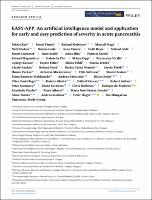| dc.contributor | Vall d'Hebron Barcelona Hospital Campus |
| dc.contributor.author | Kui, Balázs |
| dc.contributor.author | Pintér, József |
| dc.contributor.author | Molontay, Roland |
| dc.contributor.author | Nagy, Marcell |
| dc.contributor.author | Farkas, Nelli |
| dc.contributor.author | Gede, Noémi |
| dc.contributor.author | Pando Rau, Elizabeth |
| dc.contributor.author | Alberti Delgado, Piero Arturo |
| dc.contributor.author | Gomez Jurado, Maria Jose |
| dc.date.accessioned | 2022-09-09T08:31:53Z |
| dc.date.available | 2022-09-09T08:31:53Z |
| dc.date.issued | 2022-06 |
| dc.identifier.citation | Kui B, Pintér J, Molontay R, Nagy M, Farkas N, Gede N, et al. EASY-APP: An artificial intelligence model and application for early and easy prediction of severity in acute pancreatitis. Clin Transl Med. 2022 Jun;12(6):e842. |
| dc.identifier.issn | 2001-1326 |
| dc.identifier.uri | https://hdl.handle.net/11351/8098 |
| dc.description | Acute pancreatitis; Artificial intelligence; Severity prediction |
| dc.description.abstract | Background
Acute pancreatitis (AP) is a potentially severe or even fatal inflammation of the pancreas. Early identification of patients at high risk for developing a severe course of the disease is crucial for preventing organ failure and death. Most of the former predictive scores require many parameters or at least 24 h to predict the severity; therefore, the early therapeutic window is often missed.
Methods
The early achievable severity index (EASY) is a multicentre, multinational, prospective and observational study (ISRCTN10525246). The predictions were made using machine learning models. We used the scikit-learn, xgboost and catboost Python packages for modelling. We evaluated our models using fourfold cross-validation, and the receiver operating characteristic (ROC) curve, the area under the ROC curve (AUC), and accuracy metrics were calculated on the union of the test sets of the cross-validation. The most critical factors and their contribution to the prediction were identified using a modern tool of explainable artificial intelligence called SHapley Additive exPlanations (SHAP).
Results
The prediction model was based on an international cohort of 1184 patients and a validation cohort of 3543 patients. The best performing model was an XGBoost classifier with an average AUC score of 0.81 ± 0.033 and an accuracy of 89.1%, and the model improved with experience. The six most influential features were the respiratory rate, body temperature, abdominal muscular reflex, gender, age and glucose level. Using the XGBoost machine learning algorithm for prediction, the SHAP values for the explanation and the bootstrapping method to estimate confidence, we developed a free and easy-to-use web application in the Streamlit Python-based framework (http://easy-app.org/).
Conclusions
The EASY prediction score is a practical tool for identifying patients at high risk for severe AP within hours of hospital admission. The web application is available for clinicians and contributes to the improvement of the model. |
| dc.language.iso | eng |
| dc.publisher | Wiley |
| dc.relation.ispartofseries | Clinical and Translational Medicine;12(6) |
| dc.rights | Attribution 4.0 International |
| dc.rights.uri | http://creativecommons.org/licenses/by/4.0/ |
| dc.source | Scientia |
| dc.subject | Pancreatitis - Diagnòstic |
| dc.subject | Intel·ligència artificial - Aplicacions a la medicina |
| dc.subject.mesh | Pancreatitis |
| dc.subject.mesh | /diagnosis |
| dc.subject.mesh | Artificial Intelligence |
| dc.title | EASY-APP: An artificial intelligence model and application for early and easy prediction of severity in acute pancreatitis |
| dc.type | info:eu-repo/semantics/article |
| dc.identifier.doi | 10.1002/ctm2.842 |
| dc.subject.decs | pancreatitis |
| dc.subject.decs | /diagnóstico |
| dc.subject.decs | inteligencia artificial |
| dc.relation.publishversion | https://doi.org/10.1002/ctm2.842 |
| dc.type.version | info:eu-repo/semantics/publishedVersion |
| dc.audience | Professionals |
| dc.contributor.organismes | Institut Català de la Salut |
| dc.contributor.authoraffiliation | [Kui B] Department of Medicine, University of Szeged, Szeged, Hungary. Centre for Translational Medicine, Department of Medicine, University of Szeged, Szeged, Hungary. [Pintér J, Nagy M] Department of Stochastics, Institute of Mathematics, Budapest University of Technology and Economics, Budapest, Hungary. [Molontay R] Department of Stochastics, Institute of Mathematics, Budapest University of Technology and Economics, Budapest, Hungary. MTA-BME Stochastics Research Group, Budapest, Hungary. [Farkas N] Institute for Translational Medicine, Szentágothai Research Centre, Medical School, University of Pécs, Pécs, Hungary. Institute of Bioanalysis, Medical School, University of Pécs, Pécs, Hungary. [Gede N] Institute for Translational Medicine, Szentágothai Research Centre, Medical School, University of Pécs, Pécs, Hungary. [Pando E, Alberti P, Gómez-Jurado MJ] Servei de Cirurgia Hepatobiliopancreàtica i Trasplantaments, Vall d’Hebron Hospital Universitari, Barcelona, Spain. Universitat Autònoma de Barcelona, Bellaterra, Spain |
| dc.identifier.pmid | 35653504 |
| dc.identifier.wos | 000804849400001 |
| dc.rights.accessrights | info:eu-repo/semantics/openAccess |

